The Bei Shan Tang Legacy: Rubbings of Stone Engraving and Model Calligraphy (in Chinese, with English abstract and the list of plates), Edited by Ho Pik Ki, 2015, Art Museum  Since the 1970s, the Bei Shan Tang has donated approximately 2,090 ink rubbings to the Art Museum. This catalogue features seventy exquisite specimens from the collection, twenty of which are notable ink rubbings dating from the Song Dynasty, including such unique copies as the Eastern Han's Stele for Xia Cheng (once in the collection of Hua Xia's True Connoisseurship Studio, Zhenshangzhai), Wang Xizhi's works featured in the Quanzhou version of the Song-engraved Model Calligraphies from the Chunhua era (Chunhua ge tie, juan 6–8, once in the collection of Lu Gong) and the Song-carved Model Calligraphies of Yingguang Hall (Yingguangtang tie) of Mi Fu (once in the collection of Xu Weiren). Since the 1970s, the Bei Shan Tang has donated approximately 2,090 ink rubbings to the Art Museum. This catalogue features seventy exquisite specimens from the collection, twenty of which are notable ink rubbings dating from the Song Dynasty, including such unique copies as the Eastern Han's Stele for Xia Cheng (once in the collection of Hua Xia's True Connoisseurship Studio, Zhenshangzhai), Wang Xizhi's works featured in the Quanzhou version of the Song-engraved Model Calligraphies from the Chunhua era (Chunhua ge tie, juan 6–8, once in the collection of Lu Gong) and the Song-carved Model Calligraphies of Yingguang Hall (Yingguangtang tie) of Mi Fu (once in the collection of Xu Weiren).
The Stele for Xia Cheng from the Eastern Han Dynasty (clerical script) (in Chinese); Inscription on the Sweet Spring in the Jiucheng Palace from the Tang Dynasty (standard script) (in Chinese); Chunhua ge tie (Quanzhou version, juan 6–8, cursive script) (in Chinese), Edited by Ho Pik Ki, 2015, Art Museum 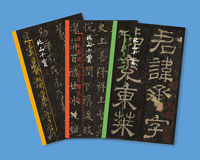 Eight rubbings of the Bei Shan Tang Collection are being considered for the fifth issue of the National Precious Ancient Books Catalogue this year. To celebrate the occasion, facsimiles of the stele for Xia Cheng from the Eastern Han Dynasty (clerical script), the Inscription on the Sweet Spring in the Jiucheng Palace from the Tang Dynasty (standard script) and the works of Wang Xizhi from Chunhua ge tie, (Quanzhou version, juan 6–8, cursive script) will be published in full colour and actual size for calligraphy practice and rubbings study. The facsimiles will include introductions, transcripts of the text, seals and colophons on the rubbings. Eight rubbings of the Bei Shan Tang Collection are being considered for the fifth issue of the National Precious Ancient Books Catalogue this year. To celebrate the occasion, facsimiles of the stele for Xia Cheng from the Eastern Han Dynasty (clerical script), the Inscription on the Sweet Spring in the Jiucheng Palace from the Tang Dynasty (standard script) and the works of Wang Xizhi from Chunhua ge tie, (Quanzhou version, juan 6–8, cursive script) will be published in full colour and actual size for calligraphy practice and rubbings study. The facsimiles will include introductions, transcripts of the text, seals and colophons on the rubbings.
Studies in Chinese Linguistics (Volume 36 Number 2), T.T. Ng Chinese Language Research Centre 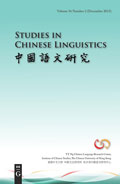 Studies in Chinese Linguistics (Volume 36 Number 2) was released. There are three articles in this issue: Studies in Chinese Linguistics (Volume 36 Number 2) was released. There are three articles in this issue:
1. Naoki Fukui: A Note on Weak vs. Strong Generation in Human Language 2. Cheng-Yu Edwin Tsai: A note on Fukui's note 3. Wei-Tien Dylan Tsai: A Case of V2 in Chinese PDF copies of these articles can be downloaded via http://www.cuhk.edu.hk/ics/clrc/. Twenty-First Century Bimonthly (October, December 2015), Research Centre for Contemporary Chinese Culture To celebrate the silver anniversary of the journal, the topic for the Twenty-First Century Review was "In Celebration of the Silver Jubilee of Twenty-First Century". Members of the journal's editorial board, Professor Hsu Cho-yun, Professor Zhang Long-xi, Professor Lee Chin-chuan, Professor Xu Ji-lin and Dr Chen Fong-ching contributed articles, reviewing the development of the journal as well as China and the world in the past 25 years.
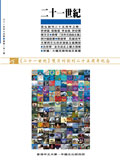 Twenty-First Century Bimonthly (Issue 151, October 2015). Five research articles were also published: Twenty-First Century Bimonthly (Issue 151, October 2015). Five research articles were also published:
Qin Hui: The Transition of Two Enlightenment Movements in the Late Qing and Early Republican Period and the Influence of "Japanese-style Liberalism": The Centennial of New Culture Movement (Part II) Chen Jian-hua: The Legacy of "Gonghe": The Literary and Cultural Reformism in Early Republican China Shen Zhi-hua: Kim Il-sung Reaches the Apex of Power: Purging Dissenters in the Party Song Zuan-you: The Post-War Renovation of Shanghai Port and the Kuomintang Government's Economic Rejuvenation Project Lin Peng: The Destiny of the Weak: Infant Abandonment in the Nanjing Region during the Great Famine
 Twenty-First Century Bimonthly (Issue 152, December 2015), the Topic of the Twenty-First Century Review was "Labour under the Suppression of the State and Capital". Professor Wang Jiang-song contributed his article "Labour Politics in Contemporary China". Five other research articles were also published: Twenty-First Century Bimonthly (Issue 152, December 2015), the Topic of the Twenty-First Century Review was "Labour under the Suppression of the State and Capital". Professor Wang Jiang-song contributed his article "Labour Politics in Contemporary China". Five other research articles were also published:
Liu Ji, Xiong Cai, De Xin-jian: An Explanation of Stages in the History of China's Population Policy: A Perspective from Political Elites Huo Xuan-ji: Relaunching the Policy of Family Planning (1962–1966) after the Great Famine Zhao Liang: Natural Disasters, Bandit Rebellions or Heavy Grain Tax? The Chinese Communist Party's Investigation of "Grain Robbery" Incidents in the East China Region during 1950 Chen Jian-hua: Republican Subjectivity and Literary Intimacy: The Literary and Cultural Reformism in Early Republican China Shen Zhi-hua: Kim Il-sung Reaches the Apex of Power: A Prelude to the "August Incident"
For issue content, please visit the Twenty-First Century Bimonthly website: http://www.cuhk.edu.hk/ics/21c/. Coping with Crisis: Ways for Family Business Survive and Thrive, Edited by Zheng Wan Tai and Chow Man Kong, 2015, Research Centre for Contemporary Chinese Culture 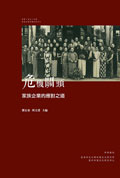 Coping with Crisis: Ways for Family Business Survive and Thrive was published in December 2015. The book was edited by Associate Director Professor Zheng Wan Tai and Honorary Research Associate Dr. Chow Man Kong. Comprising nine different articles based on research conducted on the Hang Seng Bank, Bank of East Asia, Li and Fung Group, the Ho Tung Family, the Gu Zhen Fu Family in Taiwan, the Pou Chen Group, the Zheng Guanyin Family in Macau, the Lou Kau Family and British conglomerates Jardines and Swire, the book analyses how these families and enterprises handle crises of confidence, continuity, strategy, organisational structure, market operation and finance. It is hoped that the insights obtained can serve as a reference for Chinese family enterprises in the course of their continuous development. Coping with Crisis: Ways for Family Business Survive and Thrive was published in December 2015. The book was edited by Associate Director Professor Zheng Wan Tai and Honorary Research Associate Dr. Chow Man Kong. Comprising nine different articles based on research conducted on the Hang Seng Bank, Bank of East Asia, Li and Fung Group, the Ho Tung Family, the Gu Zhen Fu Family in Taiwan, the Pou Chen Group, the Zheng Guanyin Family in Macau, the Lou Kau Family and British conglomerates Jardines and Swire, the book analyses how these families and enterprises handle crises of confidence, continuity, strategy, organisational structure, market operation and finance. It is hoped that the insights obtained can serve as a reference for Chinese family enterprises in the course of their continuous development.
A Glossary of the Zhanguoce, Edited by Ho Che Wah, Chu Kwok Fan and Cheng Lai Kuen, 2015, D.C. Lau Research Centre for Chinese Ancient Texts 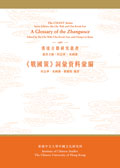 The 38th title of the CHANT series, A Glossary of the Zhanguoce, was published by the Chinese University Press in December 2015. The book made use of the CHANT database and a newly designed computer program to cull words from all extant texts to build specific glossaries for the Zhanguoce. The vocabulary first found in the Zhanguoce is listed and compiled for the first time. The book broadens the current field of study by providing empirical data regarding the development of pre-Han and Han lexicons. The 38th title of the CHANT series, A Glossary of the Zhanguoce, was published by the Chinese University Press in December 2015. The book made use of the CHANT database and a newly designed computer program to cull words from all extant texts to build specific glossaries for the Zhanguoce. The vocabulary first found in the Zhanguoce is listed and compiled for the first time. The book broadens the current field of study by providing empirical data regarding the development of pre-Han and Han lexicons.
Renditions no. 84, Research Centre for Translation 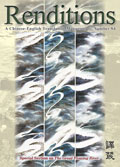 Renditions no. 84 is a general issue with a special section devoted to the first two chapters of Chi Pang-yuan's 齊邦媛 epic autobiography, The Great Flowing River, as expertly translated by John Balcom. Other features include one more chapter of Erik Honobe's fine rendering of Feng Menglong's 馮夢龍 seventeenth-century historical novel, Chronicles of the Eastern Zhou Kingdoms, together with excellent translations of two of the finest poets now writing in Chinese, Yu Jian 于堅and Yang Mu 楊牧 (the pen name of Wang Ching-hsien 王靖獻), from mainland China and Taiwan, respectively. Renditions no. 84 is a general issue with a special section devoted to the first two chapters of Chi Pang-yuan's 齊邦媛 epic autobiography, The Great Flowing River, as expertly translated by John Balcom. Other features include one more chapter of Erik Honobe's fine rendering of Feng Menglong's 馮夢龍 seventeenth-century historical novel, Chronicles of the Eastern Zhou Kingdoms, together with excellent translations of two of the finest poets now writing in Chinese, Yu Jian 于堅and Yang Mu 楊牧 (the pen name of Wang Ching-hsien 王靖獻), from mainland China and Taiwan, respectively.
Paper Cuts, by Leung Ping Kwan, translated by Brian Holton, Research Centre for Translation 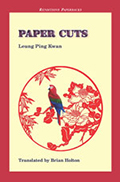 Paper Cuts, Leung Ping Kwan's (Ye Si's) landmark work of Hong Kong literature, first appeared in 1977 and has been much read and commented upon ever since. A novel that brings into being the dizzying topography of life in the fast-moving and ever-changing city, it features arresting meditations on the nature of subjectivity, personal relationships, the media world, and art and culture, and above all conveys a profound sense of the bewildering pace of change in the modern city. In a virtuoso translation by Brian Holton that does full justice to the rich style of the original, this book is a major contribution to contemporary Asian literature. Paper Cuts, Leung Ping Kwan's (Ye Si's) landmark work of Hong Kong literature, first appeared in 1977 and has been much read and commented upon ever since. A novel that brings into being the dizzying topography of life in the fast-moving and ever-changing city, it features arresting meditations on the nature of subjectivity, personal relationships, the media world, and art and culture, and above all conveys a profound sense of the bewildering pace of change in the modern city. In a virtuoso translation by Brian Holton that does full justice to the rich style of the original, this book is a major contribution to contemporary Asian literature.
Sinologists as Translators in the Seventeenth to Nineteenth Centuries, Edited by Bernhard Fuehrer and Lawrence Wang-chi Wong, 2015 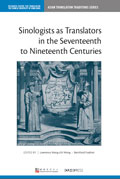 This is a collection of eleven papers from the first and second international conferences on Sinologists as Translators in the 17th–19th centuries. With a focus on the historical context of contributions by early sinologists and their translations of works in Chinese, papers within this volume explore why certain works were chosen for translation, how they were interpreted, translated, or even manipulated, and the effect they had, especially in establishing the discipline of sinology in various countries. This book aims to reconstruct the wider historical and intellectual context from which certain translations emerged, and also to open up fresh avenues for research through the extensive use of hitherto overlooked archive material. This is a collection of eleven papers from the first and second international conferences on Sinologists as Translators in the 17th–19th centuries. With a focus on the historical context of contributions by early sinologists and their translations of works in Chinese, papers within this volume explore why certain works were chosen for translation, how they were interpreted, translated, or even manipulated, and the effect they had, especially in establishing the discipline of sinology in various countries. This book aims to reconstruct the wider historical and intellectual context from which certain translations emerged, and also to open up fresh avenues for research through the extensive use of hitherto overlooked archive material.
|






















